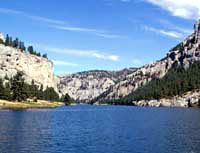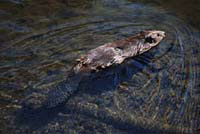For more than 25 years, the Missouri River has been like a member of my family. Whether we were backpacking the Lolo Trail in Idaho, camping at Lemhi Pass on the Montana border, or canoeing through one of many thunderstorms, the Missouri River has brought my wife, children, and me together in more ways than I can measure.

The mighty Missouri.
Unfortunately, large parts of the Missouri, like some 11,000 miles of America’s most cherished and storied rivers, have been overly tamed by the U.S. Army Corps of Engineers. And now a further threat looms over the “Mighty Mo’,” one that will carry implications for other waterways, as well. Soon the leaders of the Corps will make a monumental decision about how they manage the flow of water through the river’s lower section, from the Dakotas to St. Louis. Recent signs are that their regional staff, operating from afar in Portland, Ore., has badly misjudged the competing needs of agribusiness, barge operators, the people who visit the river for boating and fishing, and the river’s battered ecosystems.
When Lewis and Clark traveled up the Missouri in 1804 on their way to the West Coast, the river was varied and dynamic, with caving banks, snag-filled side channels, and thousands of sand bars and islands. It teemed with life.
For the better part of two centuries, however, the government’s engineers have transformed much of the muddy, free-flowing Missouri into little more than a barge canal and a series of slackwater reservoirs. The river Lewis and Clark knew is mostly lost. In pursuit of navigation and flood control, the Corps destroyed nearly all of the river’s islands, sand bars, and side channels.

Grizzly bears on the banks of the Missouri.
Photo courtesy of American Rivers
It is not surprising that more than 100 species native to the Missouri are in trouble, including many of the species that Lewis first described in his journals.
We have paid a tremendous price. But, what did we get in return? Not much. The barges the Corps said would come have never materialized. Once forecast to carry 12 million tons of cargo a year, Missouri River barges have never carried more than 3.3 million tons and now carry only 1 million tons annually, mostly sand and gravel. In contrast, barges on the Mississippi River carry more than 100 million tons each year.
Obviously, we cannot restore the river that Lewis and Clark knew. Great cities have risen along the Missouri’s banks and must be protected from flooding. But by 2004, the bicentennial of Lewis and Clark’s “Voyage of Discovery,” we can create a river they would recognize.
This month the Corps is in the midst of developing a new management plan for the river’s six big dams in eastern Montana and the Dakotas. Today, those dams still operate primarily to benefit a handful of barges, at the expense of recreation and river wildlife.
Instead, the Corps should release more water in the spring to build back the sand bars and trigger fish spawning, and less water in the summer to aid recreation and river wildlife. The river’s few barges could continue to use the river in the spring and fall, when more than 80 percent of the river’s farm-related cargo now moves. Floodplain farmers would still be able to drain their fields, according to Corps studies. And Mississippi River barges would benefit from greater Missouri River flows in the fall, when many of the nation’s farm products head to New Orleans for export.

An eager beaver.
Photo courtesy of American Rivers
The Army’s engineers have ignored the needs of recreation, river wildlife, and riverside communities for too long. If we act now, we can, by 2004, create a string of natural places along the Missouri where people can enjoy themselves and wildlife will flourish.
Restoring balance to the Missouri enjoys support all along the river. Last month, six Iowa conservation groups urged Vice Pres. Al Gore to reform dam operations. And Sens. Tom Daschle (D-S.D.), Max Baucus (D-Mont.), Byron Dorgan (D-N.D.), Kent Conrad (D-N.D.), and Tim Johnson (D-S.D.) have concluded that implementing the “split navigation season” is the best solution.
The Army and the Clinton administration now face a major test of their resolve. If they are truly committed to balanced use of the Missouri River and protection of its wildlife, they must overrule the Corps staff and reform dam operations. Dam procedures designed primarily to benefit barge operators will almost certainly lead to the extinction of several species and will certainly ignore economic reality — Missouri River recreation already produces 10 times as many benefits as barge traffic.
The approaching Lewis and Clark bicentennial in 2004 will be a once-in-a-lifetime opportunity to restore the Missouri River they traveled on. We must not let the Army Corps of Engineers squander it in 2000.


